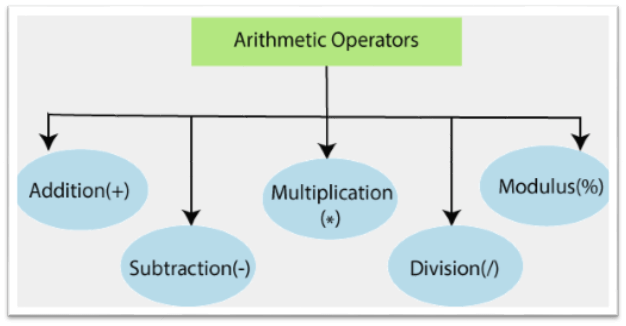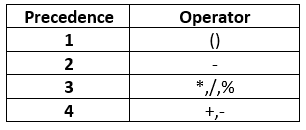Arithmetic OperatorsThe arithmetic operators are used in a PowerShell to perform the calculation of the numeric values. By using the arithmetic operators, we can add (+), subtract (-), multiply (*), or divide (/) the values. These operators also include the modulus (%) operator to calculate the remainder of the division operation. In PowerShell, the addition and multiplication operator may also be used with the strings, hash tables, and arrays. The multiplication (*) operator returns more than one copy of the input, and addition (+) operator concatenates the input. Windows PowerShell supports the following arithmetic operators: 
Arithmetic Operators PrecedencePowerShell processes these type of operators in expression according to the following precedence rules: 
Addition Operator (+)The addition operator is an arithmetic operator, which is used to add the two numbers, strings, arrays, and hash tables. Examples: Example1: This example adds two numeric values: The last command will display the value of the variable $c as 30. Example2: This example adds two strings: The last command will display the value of the variable $z as a single string "PowerShell". Example3: This example adds two arrays: The last command will display the following result of an array $z: 1 2 3 A B C Subtraction Operator (-)The subtraction operator is an arithmetic operator, which is used to subtract one numeric value from another numeric value and make a number to a negative number. Examples: Example1: This example subtract one numeric value from other value: The last command will display the value of the variable $c as 10. Example2: This example makes a number to a negative number: The last command will display the value of the variable $c as -10. Multiplication Operator (*)The Multiplication operator is an arithmetic operator, which is used to multiply the numeric values or copy the string and array values to the specified number of times. Examples: Example1: This example multiplies two numeric values: The last command will display the value of the variable $c as 200. Example2: This example is used to create the copies of the string according to a number which is specified after the multiplication operator: The last command will display the value of the variable $y as a single string "ShellShell". Example3: This example is used to create the copies of array values according to a number which is specified after the multiplication operator: The last command will display the following result of an array $y: 1 2 3 1 2 3 Division Operator (/)The Division operator is an arithmetic operator which is used to divide the two numeric values. The following example divides the two numeric values: The last command will display the value of the variable Modulus Operator (%)The modulus operator is an arithmetic operator which is used to calculate the remainder of the division operation The following example calculates the modulus of the two numeric values: The last command will display the value of the variable $c as 2.
Next TopicAssignment Operators
|
 For Videos Join Our Youtube Channel: Join Now
For Videos Join Our Youtube Channel: Join Now
Feedback
- Send your Feedback to [email protected]
Help Others, Please Share










